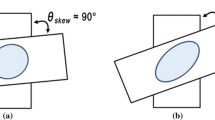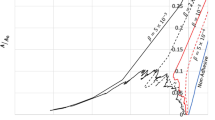Abstract
Nano-scale adhesive contact mediated by intermolecular van der Waals forces has become a typical fundamental problem in many areas. Interpretation and control of the strength and efficiency of the nano-scale adhesive contacts require a proper modeling considering the actual interfacial forces, the varying contact area, and clearance. In this article, the finite-element (FE) method is developed to model the nano-scale adhesive contact of elastic bodies with an adhesive pressure derived from the interatomic interaction Lennard-Jones potential, which permits numerical solutions for a variety of interface geometries. Compared with the analytical results from conventional Hertz, JKR, and DMT models, the validity of the FE model is verified. For nano-scale contact, the assumption of equivalent radius adopted in the Hertz model is initially investigated and proved to be improper for nano-scale adhesive contact due to the distribution variations of interfacial force caused by local contact geometry. Then adhesive contact behaviors of four typical nano-scale contact geometries inspired by tip shapes of bio-adhesive pads are investigated in detail, which are flat punch tip, sphere tip, mushroom tip, and empty cup tip. The simulation results indicate that the nano-scale tip geometry plays a dominant role on the pull-off strength. Within the investigated geometries, cup tip results in a highest adhesion efficiency followed by flat punch tip, sphere tip, and mushroom tip, respectively, which are highly geometry dependent and verified by former experimental results. The dominant effect is found coming from the contact area ratio of the adhesive area to the sticking area or the whole contact area. The FE modeling can serve a useful purpose in revealing the nano-scale geometry-based adhesion contact for surface topography design in MEMS to avoid stiction failure and for the artificial sticky feet in bionics to increase adhesion strength.






Similar content being viewed by others
References
Zhao, Y.P., Wang, L.S., Yu, T.X.: Mechanics of adhesion in MEMS—a review. J. Adhes. Sci. Technol. 17, 519–546 (2003)
Zhang, X.J., Meng, Y.G., Wen, S.Z.: Micro contact and stick-slip number between AFM probe tip and sample surface. Sci. China E 46, 537–545 (2003)
Autumn, K., Liang, Y.A., Hsieh, S.T., Zesch, W., Chan, W.P., Kenny, T.W., Fearing, R., Full, R.J.: Adhesive force of a single gecko foot-hair. Nature 405, 681–685 (2000)
Yao, H.M., Gao, H.J.: Optimal shapes for adhesive binding between two elastic bodies. J. Colloid Interface Sci. 298, 564–572 (2006)
Sylves, K., Maute, K., Dunn, M.L.: Adhesive surface design using topology optimization. Struct. Multidiscip. Optim. 38, 455–468 (2009)
Sauer, R.A.: Multiscale modelling and simulation of the deformation and adhesion of a single gecko seta. Comput. Methods Biomech. Biomed. Eng. 12, 627–640 (2009)
Chan, E.P., Greiner, C., Arzt, E., Crosby, A.J.: Designing model systems for enhanced adhesion. MRS Bull. 32, 496–503 (2007)
Johnson, K.L.: Contact mechanics. Cambridge University Press, Cambridge (1987)
Johnson, K.L., Kendall, K., Roberts, A.D.: Surface energy and contact of elastic solids. Proc. R. Soc. Lond. A 324, 301–313 (1971)
Derjaguin, B.V., Muller, V.M., Toporov, Y.P.: Effect of contact deformation on particle adhesion—determination of shape of surface of a spherical elastic particle close to zone of particle contact with a flat rigid surface. Colloid J. USSR+ 37, 412–416 (1975)
Maugis, D.: Adhesion of spheres—the JKR-DMT transition using a dugdale model. J. Colloid Interface Sci. 150, 243–269 (1992)
Varenberg, M., Peressadko, A., Gorb, S., Arzt, E.: Effect of real contact geometry on adhesion. Appl. Phys. Lett. 89, 121905–121907 (2006)
Gao, H.J., Yao, H.M.: Shape insensitive optimal adhesion of nanoscale fibrillar structures. Proc. Natl Acad. Sci. USA 101, 7851–7856 (2004)
Spolenak, R., Gorb, S., Arzt, E.: Adhesion design maps for bio-inspired attachment systems. Acta Biomater. 1, 5–13 (2005)
Spolenak, R., Gorb, S., Gao, H.J., Arzt, E.: Effects of contact shape on the scaling of biological attachments. Proc. Roy. Soc. Lond. A 461, 305–319 (2005)
Del Campo, A., Greiner, C., Arzt, E.: Contact shape controls adhesion of bioinspired fibrillar surfaces. Langmuir 23, 10235–10243 (2007)
Gorb, S.N., Varenberg, M.: Mushroom-shaped geometry of contact elements in biological adhesive systems. J. Adhes. Sci. Technol. 21, 1175–1183 (2007)
Streator, J.L.: Dynamic contact of a rigid sphere with an elastic half-space: a numerical simulation. ASME J. Trib. 125, 25–32 (2003)
Cho, S.S., Park, S.: Finite element modeling of adhesive contact using molecular potential. Tribol. Int. 37, 763–769 (2004)
Israelachvili, J.: Intermolecular and surface forces. Academic press, London (1991)
Sauer, R.A., Li, S.F.: An atomic interaction-based continuum model for adhesive contact mechanics. Finite Elem. Anal. Des. 43, 384–396 (2007)
Yu, N., Polycarpou, A.A.: Adhesive contact based on the Lennard-Jones potential: a correction to the value of the equilibrium distance as used in the potential. J. Colloid Interface Sci. 278, 428–435 (2004)
Acknowledgments
The authors would like to thank the NSFC for their financial support under grant numbers of 50730007, 50721004, and 50975154, as well as the National Key Basic Research Program of China (Grant No 2007CB607604).
Author information
Authors and Affiliations
Corresponding author
Rights and permissions
About this article
Cite this article
Zhang, X., Zhang, X. & Wen, S. Finite Element Modeling of the Nano-scale Adhesive Contact and the Geometry-based Pull-off Force. Tribol Lett 41, 65–72 (2011). https://doi.org/10.1007/s11249-010-9686-1
Received:
Accepted:
Published:
Issue Date:
DOI: https://doi.org/10.1007/s11249-010-9686-1




